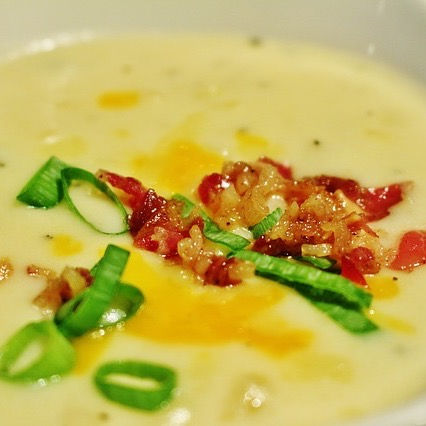The Basics of Soup Making
- Chef Savant

- Apr 12, 2020
- 6 min read
Updated: Jun 12, 2022
If you’re into soups, you already know that they’re vastly versatile and can be quite filling when you don’t have a lot of money or ingredients to work with. Some would argue that soups are more fit for winter/colder weather, but that’s simply not the case. Although cold soups aren’t wildly popular, the concept of making them takes on different meaning during the summer months, especially when you change the name to ”smoothie” and serve it chilled in a cup instead of a bowl. By default smoothies use a similar process to blended soups, simply put, one of adding ingredients together and blending them until they’re smooth, adjusting the flavors, and enjoying the results. At the core though, soups (and smoothies) are like many other foods, in that they take on the personality of whoever is making it.
Soups in general are built from a variety of flavors, but at their base, they still have very similar preparations, and basic rules of thumb to follow. To determine what this will mean in your kitchen it’s important to first understand your personal preference and how to make your soup so that it meets your standards. So what’s your favorite soup? Could it be something brothy like a Japanese Miso or is it more “Home Style” like, Chicken Noodle Soup. Maybe it’s something with more viscosity like a Chinese Egg Drop, or a soup that’s layered with complexity and flavors like the Thai Coconut Soup. Do you prefer soups thick, like a chili or a chowder or are you more into the undertones and flavors of the soup, garnished with specific textures like a crunchy crouton or soft, sweet and salty crab meat.
Typically soups will be classified in terms of what chefs like to call a “base” which is basically the type of liquid being used in the cooking process. (for example a soup categorized as broth based will be made with some sort of... well, broth... like chicken or beef; while a cream based soup will be made of some type of milk or cream etc.) Once you have the base of your soup, you can thicken it or adjust the flavors of it to suit your fancy. For Simplicity sake though, we’ll take at look at 3 of the most common base varieties, and build the understanding from there.
So the basic varieties we’ll look at are, Cream based, Tomato Based, and Broth based; all very common, and fairly easy to work with. Each one has it’s advantages and disadvantages but as mentioned earlier, they all follow some basic rules of thumb.
Cream Based
If you like creamy or cream based soups, then you know that at its base, your soup will involve heavy use of dairy like, milk, cream, or cheeses, etc. The up side to cream based soups is that they can carry a lot of flavor, very well. This is because they’re usually thicker in their make up and as the ingredients cook into “base” of it, the flavors become more pronounced in the final product.
However, that same thickness can also work against you, if you scorch/burn the cream in the cooking process, and once you get that flavor into a cream soup, there’s no getting rid of it. To avoid this pitfall, chefs will sometimes add a little broth in with the cream to widen the margin for error during the cooking process. They also re-emphasize the cream flavors by adding heavy cream or maybe a soft cheese, to it at the end which also helps to create that creamy mouth feel that we know and love. Examples of this style of soup would be: Clam Chowder, Cream of Mushroom, Loaded Potato. When making cream based soups though, there’s often a need for them to be thickened. Which is usually done with some sort of starch, either in the form of a roux, (pronounced /roo/ which is basically flour and butter) or a white wash (flour and water) or a slurry (cornstarch and water) and in some cases, even breadcrumbs or diced potatoes.
Tomato Based
In the tomato based category we find soups like: Tomato Basil, White Bean w/ Tomato & Kale, Minestrone and other vegetable heavy choices. Tomato bases tend to work well with most other vegetables, and can even enhance the flavors of meats and seafood as well. To create a tomato base some chefs will pick from a line up of fresh tomatoes, stewed tomatoes, crushed tomatoes, tomato sauce, canned tomatoes and other tomato products. Because of the water content of a tomato, its less likely to scorch as a cream based soup would, but without enough liquid to help it, it too can take on a bad flavor that can linger into the finish of your soup and even amplify, when the soup is cooled or reheated.
The acidity of the tomato base generally works well in soups that have a bit more “zing” to them as in the case of the tomato basil. However, even though the tomato acidity in a soup can add zing, having too much “zing” can also be off putting. To counteract this effect chefs will sometimes get assistance from one of the other two categories either by adding some sort of dairy, to mute the tomato acidity just a bit; or by adding a little broth, which will spread out the acidity without completely neutralizing it. Similar to the cream based, the tomato based soups are sometimes thickened with starches, but less like the cream based soups they can also be thickened with pastas, purees from other vegetables or even grains.
Broth Based
The broth based category is the broadest of the 3, because broths can stand on their own or blend with either of the previous categories to create something altogether extraordinary. A few examples of broth based soups in their own right would be: Chicken Noodle, Italian Wedding, or Beef and Barley. By extension the afore mentioned Thai Coconut Soup or a Mexican style Posole are both great examples of broth based soups that have been layered with other flavors to create a unique and specific flavor combination. Because broth bases play well with nearly everything including beans, vegetables, proteins, and grains, they often don’t require as much thickening as the other 2 categories.
So how will you make your soup? A general rule of thumb for more brothy soups is to use about a 2/3 ratio for the hearty ingredients and aromatics, and the remaining 3rd for the broth. A slow simmer will usually bring out the liquids of the aromatics and add a little more flavor to the broth as it cooks. Of course you can make it thinner with more broth, but just remember, if you do, to adjust the spices/flavors to compensate for the additional liquid that you use. For a tomato or cream based soups, the making of the ratio depends on how thick you want your finished product to be. You can always add a bit more liquid to your base, and in addition to using a starch to thicken in either of these categories, you could simply allow them to simmer and reduce, which will also concentrate the overall flavors. Don’t forget, the recipe rules of how each ingredient fits into a “job category” when you choose a recipe. (See post on Recipe Reading). Take a moment to look over the recipe and determine which category the ingredients support, and how best to use them in your soup. Troubleshoot your process and fine tune it until you get the signature that works best for you. So now that you have the basic “how” of making a soup, below are a few basic ingredients to get you to thinking in terms of “what” you may want to put into your soup.
Try This
Chicken Noodle Soup
Take Onions, Carrots, Celery, Bay Leaves, Rotisserie Chicken, Chicken Broth, Your favorite Pasta (Long Noodles work best when broken in half, but you can also use penne, rotini or farfalle or bow tie pasta)... add your own twist to this and create your signature chicken noodle soup. (Twist options: mushrooms, potatoes, red bell peppers, spinach, lemon zest)
White Bean & Sausage w/ Kale Soup
Kale blanched and chopped, Italian sausage crumbled, diced tomatoes, whited beans, diced onions, diced carrots, and chicken broth.

Loaded Potato Soup
Diced potatoes (yellow or white), half & half, vegetable broth, shredded cheese, sour cream, diced onions, diced bacon, butter, flour.
(Twist Options... you can also add flavors in the form of spice blends or aromatic mixtures (onion soup mix, ranch dressing mix, chicken bullion, etc), and you can top it with fried onions, potato chips or fresh green onions.)
Tortellini & Roasted Mushroom Soup
Tortellini, (your choice, cheese stuffed, chicken stuffed etc; you can also substitute a ravioli of your choice). Your choice of mushrooms for roast (domestic button mushrooms, cremini, shiitake, king or oyster mushrooms... which work well when roasted with a little salt, pepper, and fresh thyme.) Roast the mushrooms at 400 degrees for about 20 minutes. Add a bit of fresh spinach, stewed tomatoes, chicken broth, and grated Parmesan...
Basic Tomato Basil
Stewed Tomatoes, fresh and/or dried Basil, Heavy Cream or Half & Half, Chicken Broth, salt/pepper.
(Twist Options... you can also use a Tomato Sauce instead of Stewed Tomatoes. You can also add paprika for a little color and spice, or a soft cream style cheese like a Boursin or a Alouette, or whipped cream cheese to tone down the acidity... if you prefer a smoother soup, try putting it into a blender once it has simmered for about 15 minutes; finish it by tossing in your choice of chopped fresh herbs to add more depth).
Tell us how it turned out!











































Comments